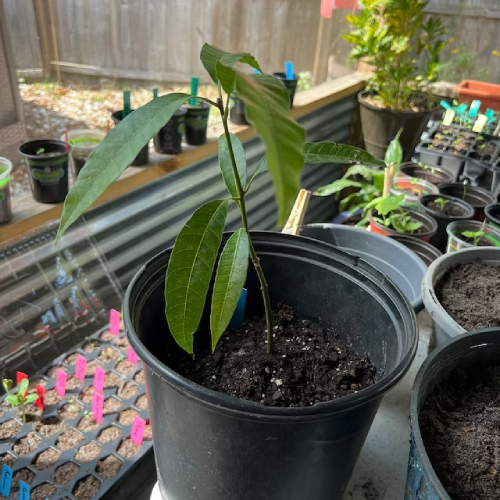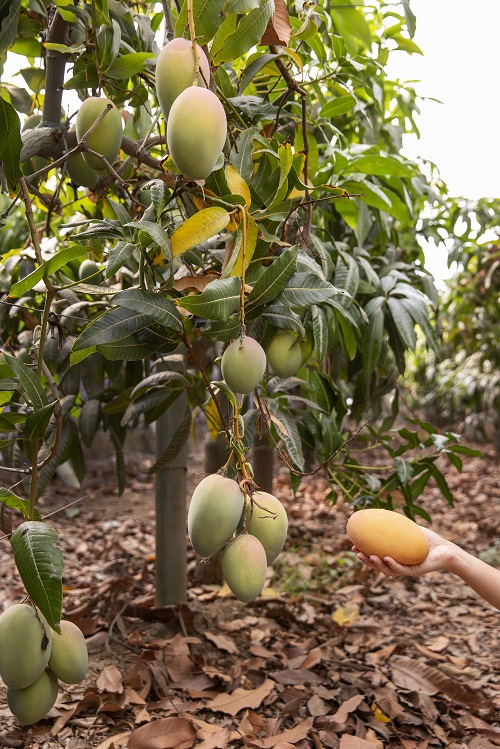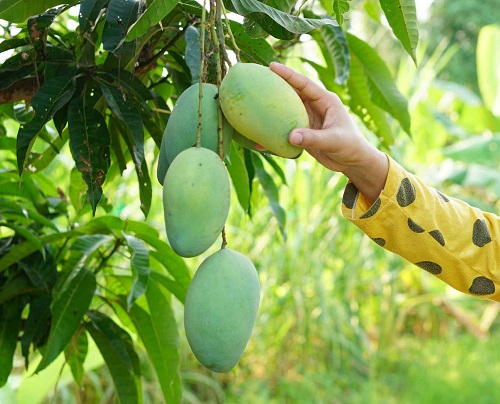This comprehensive Ataulfo Mango growing and planting guide will help you grow this tropical fruit with ease!

Ataulfo Mango is a delicious cultivar that offers abundant harvest in a small space. Keep on reading to know how to grow this tropical delight!
Botanical Name: Mangifera indica ‘Ataulfo’
USDA Zones: 9b-12
Check out the Article on Growing Mango Trees here
Ataulfo Mango Information
Origin and Cultural Significance
- Historical Roots: The Ataulfo Mango, sometimes known as the Honey Mango, is proudly a Mexican fruit with a history woven into the vibrant fabric of the Chiapas region. This fruit possesses solid cultural ties in addition to its physical foundations.
- Culinary Treasure: The Ataulfo Mango, prized for its exceptional sweetness and velvety texture, has become a delicious masterpiece in traditional Mexican dishes and international cuisine.
Taste
- Golden Nectar: As you indulge in the first bite of an Ataulfo Mango, prepare for a sensory symphony of honey-like sweetness that transports your taste buds to the heart of the tropics.
- Velvet on the Palate: As you continue your journey, the mango’s rich, creamy texture will reveal itself, touching your taste buds with a luscious velvet touch that is as delicious as it is unique.
Aesthetic Appeal
- Gilded Perfection: Observe the Ataulfo Mango, which is stunning in its golden-yellow exterior and a testament to the flavorful treasure trove that lies within.
- Elongated Elegance: Every bite of the mango is a delicious delight because of its long, slender form, which is visually appealing, ensuring every taste is a juicy revelation.
Know Is Mango a Citrus Fruit or Stone Fruit? here
Propagating the Ataulfo Mango
If you’re looking to propagate Ataulfo Mango trees, there are several methods to consider. Below are detailed guides for each method.
Methods of Propagation
Grafting
Tools Needed:
- Rootstock tree
- Scion (Ataulfo Mango branch)
- Grafting knife
- Grafting tape
Steps:
- Choose Rootstock: Select a healthy, young mango tree to serve as the rootstock.
- Prepare Scion: Cut a 4-6 inch piece from a healthy Ataulfo Mango tree.
- Make Cuts: Create matching cuts on both the rootstock and scion.
- Join and Secure: Fit the scion onto the rootstock and secure it tightly with grafting tape.
- Monitor: Keep an eye on the graft; it should heal and start growing within 4-6 weeks.
Air Layering
Tools Needed:
- Sphagnum moss
- Plastic wrap
- Twist ties or string
Steps:
- Select a Branch: Choose a healthy, one-year-old branch.
- Make an Incision: Create a 1-2 inch upward slanting cut on the branch.
- Insert Moss: Wet sphagnum moss and insert it into the incision.
- Wrap and Secure: Wrap the moss and incision with plastic wrap and secure it with twist ties.
- Wait for Roots: In 2-3 months, roots should appear in the moss.
- Cut and Plant: Once roots are visible, cut the branch below the new root ball and plant it.
Growing from Seed
Tools Needed:
- Ataulfo Mango seed
- Potting soil
- Pot
Steps:
- Extract the Seed: Remove the seed from a ripe Ataulfo Mango.
- Prepare the Seed: Clean off all flesh and let it dry.
- Plant the Seed: Plant the seed in a pot filled with well-draining potting soil.
- Water: Water the soil thoroughly.
- Place in Warm Location: Keep the pot in a warm, sunny spot.
- Germination: The seed should germinate within 1-3 weeks.
- Transplant: Once the seedling has grown a few inches, it can be transplanted to a larger pot or directly into the ground.
Pro Tip: Get a grafted tree from a nearby garden center for a speedy harvest.
Requirements for Growing Ataulfo Mango
Sunlight
Ataulfo Mango trees require a minimum of 6-8 hours of direct sunlight per day for optimum growth and fruit production. South or West-facing location is preferable to ensure ample sun exposure.
Soil
Combination of sand and loam can provide both good drainage and adequate nutrient retention, making it a commonly recommended soil type for mango trees. A pH range of 5.5 to 7.5 is generally optimal for mango trees.
When to Side Dress
- Early Spring: Just before the new growth season begins.
- Mid-Summer: During fruit set and development.
- Incorporate well-rotted compost or manure to enrich the soil with essential nutrients.
If you are growing mangoes in container, then try this mix:
- Garden soil: 40% – Source of essential minerals and provides structure.
- Compost: 30% – Adds organic matter, improves water retention, and offers slow-release nutrients.
- Coarse Sand: 20% – Enhances drainage, preventing waterlogged conditions.
- Perlite or Vermiculite: 10% – Further aids in drainage and aeration, helping root development.
Water
- Concentration of Sugars: Limited watering can lead to water stress, concentrating the sugars in the fruit and making them sweeter.
- Taste Deterioration: Extreme water stress may cause bitterness or an off-flavor.
- Dilution Effect: Excessive watering can dilute the flavors, resulting in bland-tasting fruit.
- Texture: Overwatering may also negatively affect the texture, making the flesh more watery.
Reducing water supply a few weeks before harvesting can enhance sweetness and flavor concentration. Adequate watering is crucial during flowering and fruit set for optimal fruit quality.
Water the plant when the topsoil feels a little dry to the touch.
Temperature
Optimal Temperature Ranges
Flowering Stage
- Minimum Temperature: 60°F (15°C)
- Maximum Temperature: 80°F (27°C)
Fruit Set and Development
- Minimum Temperature: 70°F (21°C)
- Maximum Temperature: 90°F (32°C)
Ripening Stage
- Minimum Temperature: 75°F (24°C)
- Maximum Temperature: 90°F (32°C)
Extremely high temperatures (above 95°F or 35°C) can result in poor fruit development and may cause sunburn on the fruit. Also, cold temperatures below 50°F (10°C) during the flowering stage can inhibit flowering and negatively affect the fruit set.
Taking Care of Ataulfo Mango
Fertilizer
Use a balanced fertilizer such as 10-10-10 or 14-14-14. Do refer to the label for dosage and instructions.
Young Trees
- First Year: Fertilize once every 2-3 months to support initial growth.
- Second Year: Fertilize quarterly or as needed based on tree growth.
Mature Trees
- Pre-Flowering Stage: Fertilize as the tree begins new vegetative growth, typically in late winter or early spring.
- Fruit Set: Apply fertilizer once the fruits have set, usually a few weeks after flowering.
- Mid-Season: Consider a light application mid-way through the fruit development phase, usually around early to mid-summer.
Pro Tip: During the fruiting stage, switch to a high-potassium fertilizer like 0-0-50.
Pruning
- The ideal time to prune Ataulfo Mango trees is immediately after harvest, typically in late summer or early fall.
- Avoid pruning during flowering or fruit-setting stages, as it can stress the tree and reduce fruit yield.
- Cut away any dead, diseased, or broken branches first.
- Remove suckers growing from the base and water sprouts that shoot vertically from branches as they divert energy from fruit production.
- Trim branches that are overcrowding the center of the tree to improve air circulation and sunlight penetration.
- Trim back overly long branches to a manageable size, but avoid removing more than 20-30% of the total canopy in a single session.
- Aim for a balanced, pyramidal shape for better structural integrity and easier harvesting.
Pests and Diseases
Common Pests
Mango Fruit Fly
- Identification: Small, yellow or brown flies; larval infestation leads to rotten fruit.
- Management: Use pheromone traps and apply fruit fly-specific insecticides.
Mango Hopper
- Identification: Small, green or yellow insects that cause yellowing and curling of leaves.
- Management: Use neem oil sprays or insecticidal soap.
Mealybugs
- Identification: White, cotton-like masses on leaves and fruit.
- Management: Apply insecticidal soap or use biological control agents like ladybugs.
Common Diseases
Anthracnose
- Identification: Dark, irregularly shaped lesions on leaves, flowers, and fruit.
- Management: Apply copper-based fungicides and ensure good air circulation.
Powdery Mildew
- Identification: White powdery substance on leaves and flowers.
- Management: Use sulfur-based fungicides and improve air circulation.
Bacterial Black Spot
- Identification: Black, raised spots on leaves and fruit, which may cause premature fruit drop.
- Management: Copper-based sprays can help, but prevention through proper spacing and pruning is more effective.
Harvesting Ataulfo Mango
Time to Harvest After Planting
From Seed
- Ataulfo Mango trees grown from seed can take up to 8 years to bear fruit.
From Grafted Trees
- Grafted trees are generally quicker and may start producing fruit in as little as 4 to 6 years after planting.
Signs of Maturity
Color Change
- The skin changes from green to a deeper, golden yellow.
Softness
- Gently press the fruit; a mature one will yield slightly to gentle pressure.
Fragrance
- Ripe Ataulfo Mangoes emit a fruity aroma near the stem.
Shape
- The fruit will appear plump and rounded.
How to Pick the Fruits
Tools Required
- Pruning Shears
- Harvesting Basket or Bag
- Ladder (for tall trees)
Picking Technique
- Identify the Right Fruit: Look for mangoes that meet the maturity indicators above.
- Position the Shears: Place the pruning shears near the stem, about an inch above the mango.
- Clean Cut: Make a clean, swift cut to minimize damage to the tree and fruit.
- Handle with Care: Hold the cut mango gently to avoid bruising the fruit.
- Place in Basket: Gently place the harvested mango in your basket or bag, ensuring it does not get damaged by other fruits.
Check out Different Types of Mangoes here
Ataulfo Mango – FAQs
1. What is the best time to plant Ataulfo Mango trees?
The best time to plant Ataulfo Mango trees is in the late spring or early summer when the weather is warm and all danger of frost has passed.
2. How long does it take for an Ataulfo Mango tree to bear fruit?
Grafted Ataulfo Mango trees may start producing fruit in as little as 4 to 6 years, while seed-grown trees can take up to 8 years.
3. What are the ideal soil conditions for Ataulfo Mango trees?
Well-draining, slightly acidic soil with a pH of 5.5-7.5 is ideal for Ataulfo Mango trees.
4. How much water do Ataulfo Mango trees require?
The trees need consistent watering but should not be waterlogged. Reduce watering during the winter months.
5. What type of fertilizer should be used for Ataulfo Mango trees?
A balanced fertilizer with a ratio of Nitrogen:Phosphorus:Potassium (N:P:K) such as 10-10-10 is generally recommended.
6. When is the right time to harvest Ataulfo Mangoes?
Ataulfo Mangoes are usually ready to harvest when they change color from green to a deep, golden yellow and emit a fruity aroma.
7. How should Ataulfo Mango trees be pruned?
Pruning should be done after harvest to remove dead wood and promote air circulation. The objective is to maintain a balanced canopy.
8. What are common pests and diseases affecting Ataulfo Mango trees?
Common pests include mango fruit flies and mango hoppers. Diseases often include anthracnose and powdery mildew.
9. Are Ataulfo Mangoes the same as Champagne Mangoes?
Yes, Champagne Mango is another name for Ataulfo Mangoes, and the terms are often used interchangeably.
10. Can Ataulfo Mangoes be grown indoors?
While it is possible to grow Ataulfo Mango trees indoors in containers, it is challenging to get them to bear fruit without optimal sunlight and space.






